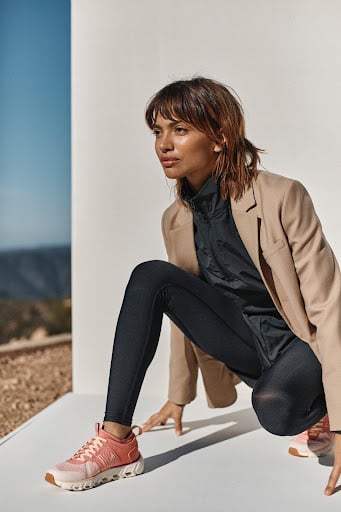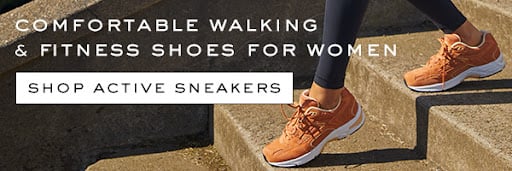Whether it’s time to take the dog for a walk, head to the gym, or shoot some hoops, you might find it easy to just grab any pair of sneakers and hit the road. But if you want to make the most out of each activity (and make sure your feet are properly supported), you’ll want to take a second look at the different shoe options available to you.
At this point, you might find yourself wondering, are flat shoes good for running, can’t I use my walking shoes for every adventure, or are training shoes good for walking as well as my gym sessions?
Though some crossover can happen, the general consensus states that different athletic shoes belong to different kinds of performance. Since trainers and walking shoes serve different functions, you shouldn’t use them in place of each other. After all, you wouldn’t bring roller skates to an ice rink, right?
Learning the difference between training shoes and walking shoes can not only improve your performance, but it can also help protect you from injury. Luckily, we’re about to start a training session of our own. So, get ready to listen and lace up accordingly.
Training Shoes vs. Walking Shoes: What’s the Difference?
Many people don’t realize that training shoes and walking shoes serve different purposes. It’s easy to dub them all “tennis shoes” or “sneakers” and call it a day. However, if you care about advancing your performance while keeping your foot health in check, you’ll want to look a little closer at the differences between these two types of shoe.
Training Shoes
Training shoes prioritize versatility. With the help of a wider sole, trainers focus on providing safe lateral movement during quick shifts of weight. In addition, trainers are designed to withstand high-impact1 (and mostly indoor) activities. As a result, their soles generally provide more cushion and weight to the athletic shoe.
These types of athletic footwear works best for activities such as:
- High-intensity training
- Basketball
- Boxing or kickboxing
- Aerobic exercise
- Jumping
Walking Shoes
While trainers can support your feet during a variety of activities, walking shoes mainly focus on just one—can you guess what it is?
As their name suggests, walking shoes prioritize functional walking. Instead of focusing on the importance of side-to-side movement like trainers, walking shoes work hard to master the art of front-to-back movement.
And when you compare these two types of shoes, it’s clear that their designs don’t lend themselves to much overlap. Trainers can work fine for walking short distances or running errands, but if you use walking as a primary form of exercise, it’s in your best interest to get a separate pair of shoes just for that purpose.
What Makes A Good Walking Shoe?
Walking has proven incredibly beneficial to our overall health and wellness. In fact, walking can help decrease your stress levels, your risk of heart disease, and your body fat while boosting your endurance and improving your balance.2 With so many reasons to prioritize walking, you should ensure that your shoes do their part.
When looking for a quality walking shoe, you should focus on support, flexibility, cushioning, and overall comfortability. Let’s walk through each of these aspects together.
Stable Support
Walking shoes require firm support to keep the feet properly aligned. Most walking shoes achieve this with snugly fitting lateral edges and extra cushioning around the heel. This allows the foot to absorb shock and roll forward with ease.
Though the standard design for walking shoes remains similar, you may need to consider minor alterations depending on the state of your arches.
- High arches – When you have high arches, you may not receive enough shock absorption as less of your foot comes into contact with the ground. In this case, a well-cushioned midsole may come in handy. The extra padding can help absorb shock as well as prevent arch collapse.
- Normal arches – A normal arch will naturally support the body without putting too much pressure on the inside or outside of the foot. If you have normal arches, you can’t go wrong with the big three: stability, support, and cushioning.
- Flat arches – A flat arch means that most of your foot makes contact with the ground when you step, which can lead to excess strain on the muscles and joints. A proper walking shoe for flat arches will have a firm midsole and raised arch support to relieve pressure.
To get the most out of your walking, you should ensure your shoe works with your feet, not against them. To that end, consider putting your trust in orthotic expert-approved footwear to take you where you need to go.
Optimal Flexibility
The foot has many talents, and different types of physical activity may demand different ones. For instance, while some sports require supportive shock absorption, others need lateral movement.
Walking, however, is all about that heel-to-toe action, and you can’t properly roll the foot in this way without the right kind of midsole.
When looking for a quality walking shoe, look for a midsole that feels more flexible than rigid. Free range of motion means your foot can splay out naturally (which can even keep it from cramping).
Appropriate Cushioning
High-performance shoes like trainers will have chunky outsoles and padded insoles. These cushions act as necessary barriers that absorb shock and protect the foot from damage.
Walking shoes often don’t share these characteristics. However, even though walking isn’t a high-impact activity, proper walking shoes still require adequate cushioning—you just don’t want a shoe that overdoes it.
So, when evaluating proper cushioning, you should take into consideration the following shoe terminology:
- Midsoles – The best walking shoes will have thin padding in the soles to keep your feet feeling light and balanced.
- Heels – Most cushioning in walking shoes will surround the heels. By ensuring proper padding in this area, you can likewise ensure your foot experiences the type of support and shock absorption that’s optimal for heel-to-toe motion.
- Heel-to-toe drop – Although heel support remains an essential facet of walking shoes, too much cushioning could affect the heel-to-toe drop. This term refers to the evenness of cushioning throughout the shoe.3 Too much cushioning in the heel could increase the drop number, which can alter walking mechanics. To that end, it’s best to find a shoe as close to “zero-drop” as possible.
By following these guidelines and prioritizing proper cushioning, you can feel like you’re walking on clouds (even if you’re just walking around the dog park).
Comfortable Fit
The most crucial component to consider when shopping for walking shoes is the fit. After all, if you’re going to spend hours walking around your neighborhood, the mall, a new city, etcetera, you’ll want to feel comfortable with the company you keep (a.k.a., the shoes on your feet).
Walking shoes should feel snug but never tight. Not only can too-tight shoes cause discomfort, but they can also lead to joint inflammation, as well as bone deformities in extreme cases.4 Getting a slightly looser pair of shoes and tightening them with laces is always preferable to choosing a pair that’s a bit too snug.
Want to guarantee the best fit possible? Try these helpful tips when shopping for your next perfect pair:5
- Measure your feet while standing (feet width expands under pressure)
- Measure your feet at the end of the day to account for routine swelling
- Allow half an inch of room in the toe box
- Opt for a shoe that’s half a size larger
With well-fitted shoes on your feet, you can keep pushing the boundaries of your walking routine without sacrificing comfort.
Types of Walking Shoes
As is the case with athletic shoes, walking shoes come in many different shapes and sizes. We’ve already discussed possible design alterations for optimal foot health, but there’s even more to consider. In particular, your preferred walking environment can impact a walking shoe’s outsole, midsole, and treading.
So, picture yourself on your favorite walk. Where do you see yourself?
- On pavement – If you like to do your fitness walking on paved roads made of asphalt or concrete, you may want to prioritize shoes with adequate (but lightweight) cushioning. Paved roads have little give, so you’ll want a shoe that absorbs the shock while keeping you quick on your toes.
- On an urban path – Paths made of cobblestone or brick can feel a little uncomfortable with a very lightweight shoe. You may want to consider a sturdier trail hiking shoe to give yourself the support you need to keep your balance and prevent injuries.
- On a nature trail – Avid nature walkers should have plenty of traction on their athletic shoes to avoid slips or sprained ankles. However, a sturdy sole doesn’t mean you need an inflexible shoe. You can still opt for a lightweight, flexible walking shoe that enables your foot to roll properly despite dirt and debris, while providing ankle support.
Ultimately, wherever you like to walk the walk, you should make sure you do it with a shoe that’s designed for the terrain.
Walk to Victory with Vionic Shoes
At Vionic Shoes, we pride ourselves on creating foot-forward designs that combine stability, cushioning, and arch support. Whether you’re looking for walking shoes, training shoes, or going-out-on-the-town shoes, we’re confident we can introduce you to your perfect match.
Browse our collection today to start stepping out in comfort and style—no matter what adventures lie ahead.
Sources:
- “Walking Shoes Vs. Cross-Training Shoes.” Ankle and Foot Institute of Texas. https://www.aafoot.com/post/walking-shoes-vs-cross-training-shoes-foot-specialist-north-fort-worth
- “Walking For Good Health.” Better Health Channel. https://www.betterhealth.vic.gov.au/health/healthyliving/walking-for-good-health
- Dura, Tim. “How Does Heel-to-Toe Drop in Running Shoes Impact Heel Pain?” Podiatry Today. November, 2022. https://www.hmpgloballearningnetwork.com/site/podiatry/case-study/how-does-heel-toe-drop-running-shoes-impact-heel-pain
- “Foot Problems with Ill-Fitting Shoes.” Adelaide Foot and Ankle. https://adelaidefootandankle.com.au/foot-problems-ill-fitting-shoes/
- Forcum, Ted et al. “Guidelines for Buying Walking Shoes.” Spine Health. 24 May, 2004. https://www.spine-health.com/wellness/exercise/guidelines-buying-walking-shoes



Leave a Reply